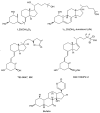Novel vitamin D compounds and skin cancer prevention
- PMID: 24494039
- PMCID: PMC3897591
- DOI: 10.4161/derm.23939
Novel vitamin D compounds and skin cancer prevention
Abstract
As skin cancer is one of the most costly health issues in many countries, particularly in Australia, the possibility that vitamin D compounds might contribute to prevention of this disease is becoming increasingly more attractive to researchers and health communities. In this article, important epidemiologic, mechanistic and experimental data supporting the chemopreventive potential of several vitamin D-related compounds are explored. Evidence of photoprotection by the active hormone, 1α,25dihydroxyvitamin D3, as well as a derivative of an over-irradiation product, lumisterol, a fluorinated analog and bufalin, a potential vitamin D-like compound, are provided. The aim of this article is to understand how vitamin D compounds contribute to UV adaptation and potentially, skin cancer prevention.
Keywords: 1α,25-dihydroxyvitaminD3; DNA damage; bufalin; photocarcinogenesis; photoimmune suppression; photoprotection; skin cancer prevention; vitamin D compounds; vitamin D photoproducts.
Figures





Similar articles
-
Protection from Ultraviolet Damage and Photocarcinogenesis by Vitamin D Compounds.Adv Exp Med Biol. 2020;1268:227-253. doi: 10.1007/978-3-030-46227-7_12. Adv Exp Med Biol. 2020. PMID: 32918222 Review.
-
Evidence for Involvement of Nonclassical Pathways in the Protection From UV-Induced DNA Damage by Vitamin D-Related Compounds.JBMR Plus. 2021 Sep 29;5(12):e10555. doi: 10.1002/jbm4.10555. eCollection 2021 Dec. JBMR Plus. 2021. PMID: 34950826 Free PMC article.
-
CYP11A1 in skin: an alternative route to photoprotection by vitamin D compounds.J Steroid Biochem Mol Biol. 2015 Apr;148:72-8. doi: 10.1016/j.jsbmb.2014.11.015. Epub 2014 Nov 15. J Steroid Biochem Mol Biol. 2015. PMID: 25448743 Review.
-
Skin cancer prevention: a possible role of 1,25dihydroxyvitamin D3 and its analogs.J Steroid Biochem Mol Biol. 2005 Oct;97(1-2):137-43. doi: 10.1016/j.jsbmb.2005.06.006. Epub 2005 Jul 20. J Steroid Biochem Mol Biol. 2005. PMID: 16039116
-
1α,25-Dihydroxyvitamin D3 reduces several types of UV-induced DNA damage and contributes to photoprotection.J Steroid Biochem Mol Biol. 2013 Jul;136:131-8. doi: 10.1016/j.jsbmb.2012.11.003. Epub 2012 Nov 16. J Steroid Biochem Mol Biol. 2013. PMID: 23165145 Review.
Cited by
-
The Impact of Vitamin D on Skin Aging.Int J Mol Sci. 2021 Aug 23;22(16):9097. doi: 10.3390/ijms22169097. Int J Mol Sci. 2021. PMID: 34445803 Free PMC article. Review.
-
The vitamin D receptor: a tumor suppressor in skin.Adv Exp Med Biol. 2014;810:282-302. doi: 10.21236/ada614241. Adv Exp Med Biol. 2014. PMID: 25207372 Free PMC article. Review.
-
Inhibitory effect of traditional oriental medicine-derived monoamine oxidase B inhibitor on radioresistance of non-small cell lung cancer.Sci Rep. 2016 Feb 24;6:21986. doi: 10.1038/srep21986. Sci Rep. 2016. PMID: 26906215 Free PMC article.
-
The Role of Classical and Novel Forms of Vitamin D in the Pathogenesis and Progression of Nonmelanoma Skin Cancers.Adv Exp Med Biol. 2020;1268:257-283. doi: 10.1007/978-3-030-46227-7_13. Adv Exp Med Biol. 2020. PMID: 32918223 Free PMC article. Review.
-
New therapeutic aspects of steroidal cardiac glycosides: the anticancer properties of Huachansu and its main active constituent Bufalin.Cancer Cell Int. 2019 Apr 11;19:92. doi: 10.1186/s12935-019-0806-1. eCollection 2019. Cancer Cell Int. 2019. PMID: 31011289 Free PMC article. Review.
References
-
- Nowson CA, McGrath JJ, Ebeling PR, Haikerwal A, Daly RM, Sanders KM, et al. Working Group of Australian and New Zealand Bone and Mineral Society, Endocrine Society of Australia and Osteoporosis Australia Vitamin D and health in adults in Australia and New Zealand: a position statement. Med J Aust. 2012;196:686–7. doi: 10.5694/mja11.10301. - DOI - PubMed
-
- AIHW. Non-melanoma skin cancer: general practice consultations, hospitalisation and mortality. Australian Institute for Health and Welfare 2008: http://australia.gov.au/directories/australia/aihw.
-
- Mason RS, Dixon KM, Sequeira VB, Gordon-Thomson C. Sunlight protection by vitamin D compounds. In: Feldman D, Pike JW, Adams JS, eds. Vitamin D. 3rd edition. San Diego: Elsevier, 2011: 1943-53.
Publication types
LinkOut - more resources
Full Text Sources
Other Literature Sources
Research Materials
